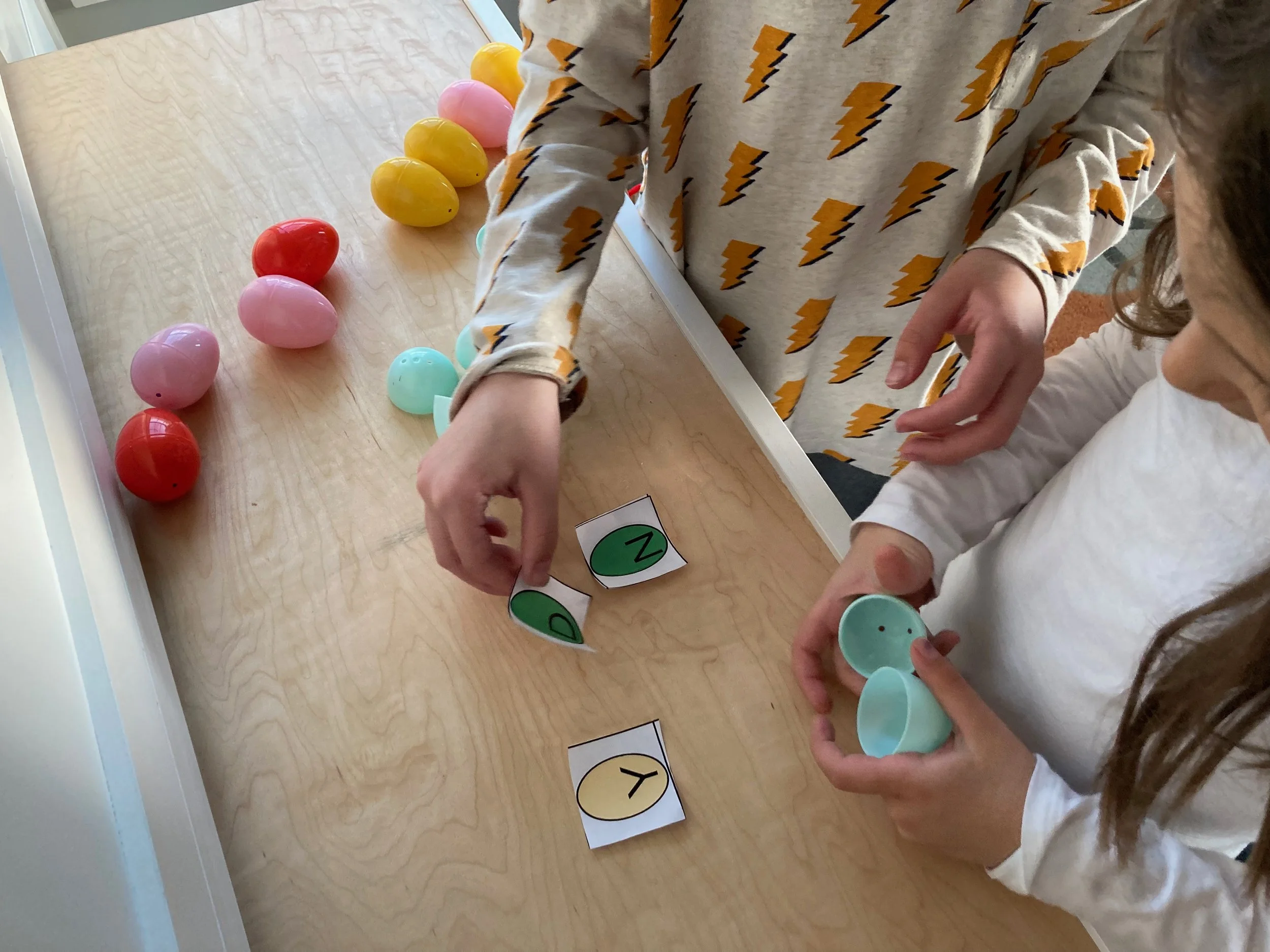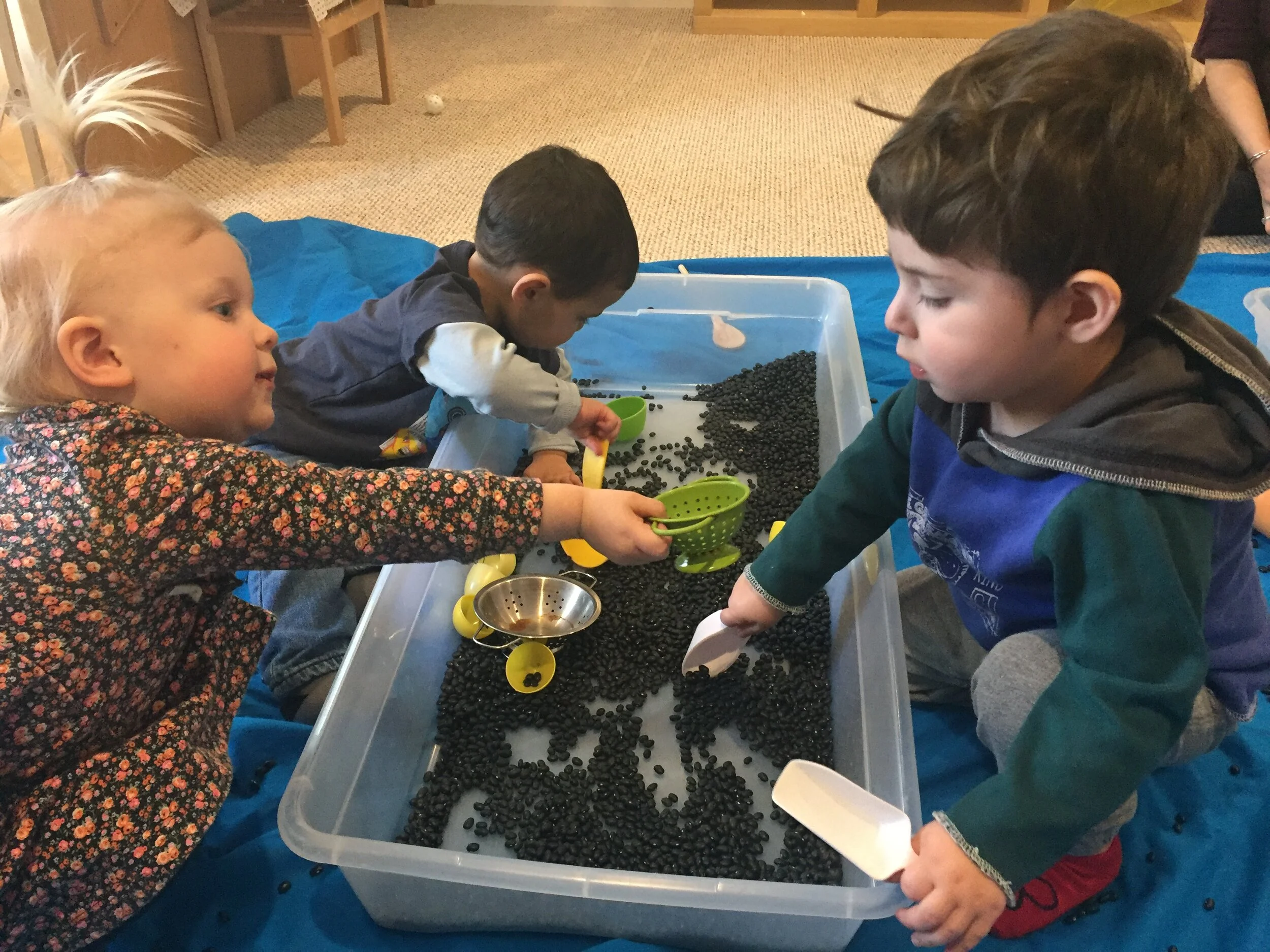HARMONY IN THE EARLY YEARS:
NURTURING CHILDREN’S LEARNING & CREATIVITY THROUGH PLAY
Welcome! Each month, Harmony In The Early Years explores topics helping you set the stage to engage little ones' insatiable urge to learn, play, and discover—planting seeds allowing each child to blossom into an excited, engaged, life-long learner.
Drawing from our decades of early education experience and Harmony's unique formula of observant attention to slowing down, connecting, and refueling, we'll share tricks of our trade to infuse your days with harmony.
Whether you're a parent, caregiver, or early educator of children from birth to age 6, we are here to support and inspire you as you journey through these years of magical discovery.
What our Pre-K & Kindergarten Program is All About
When parents ask us whether their preschooler is progressing appropriately toward kindergarten readiness, they are often surprised that our response has little to do with academic skills. Though we present the basics of numbers, math, letters, reading, writing, and science to children age 2 and beyond, the true measure of kindergarten readiness comes from the social-emotional behavioral foundation your child is working to master every day throughout their preschool years.
Whether your children begin their Harmony experience at age 2 in our Transitional Preschool program, ages 3-4 in our Preschool program, or ages 4.9-6 in our Pre-K & Kindergarten program, our primary focus as they learn through play is to develop their Social-Emotional Learning Skills—only once they have mastered these can they fully shift to Intellectual Academic Skill-Building…
Observing Play Schemas Through Simple Materials
Learning never ends at Harmony—both for our teachers, and the children who arrive here to play each day. Throughout the year, as part of our Harmony Approach to individualized, play-based learning, we are constantly rotating the play materials in each classroom, and love to silently introduce new, basic items to observe how the children choose to interact with them. Though it may sound simple—and of course, everything we do at Harmony is rooted in simplicity—each child approaches objects through his or her own lens, and as we observe this, we not only get a window into their perspective and what they are learning, we watch their play inspire new play ideas among the other children, while also inspiring us to incorporate additional items that build on their learning.
For Play-Based Learning, Less Is More!
It’s that time of year again! As parents, we can’t help but share our little ones’ joy and wonder as they take in the holiday lights, music, and get swept up in the swirling excitement of the season. Yet that excitement can so easily morph into pressure and overstimulation for all of us.
Last December, we shared our favorite strategies to sidestep the overstimulation pitfalls and simplify your holidays—we still highly encourage and recommend all of them! This holiday season, to accompany those tips to simplify the holidays, we’ve put together a handful of our favorite simple gift ideas for you to give your littles—they are the kinds of materials children enjoy playing with at Harmony every day, along with easy ideas for how to use them in your home.
Introducing harmonycurriculum.com
This is an incredibly exciting day for us at Harmony. It marks the realization of a goal we barely dared dream of when we founded Harmony Natural Learning Center in Newbury, MA, in 2010, as a space for families of children 5 and under to engage in the joys of simple play together. At that time, we offered Parent/Child Classes for babies and toddlers, parent coaching, and parent workshops.
As word spread about Harmony and community demand grew, we began offering Preschool (ages 3-5), Transitional Preschool (ages 2-3), and eventually Multi-Track Kindergarten (ages 4-6). When families were forced to isolate at home during the pandemic, it also forced our hand to fulfill our long-held dream…
Maximizing Your Child’s Learning Journey, Together
What is the best way to assess young children’s learning and development in school and comprehensively relay it to parents? This question has long been debated within the education community—across all student age groups. While many schools have settled on teachers filling out standard checked-box assessment sheets with limited commentary (Child exercises self-control; Child recognizes all colors; Child recognizes number 0-9…), at Harmony, that just doesn’t feel authentic to who we are, as educators who seek to holistically understand each child. Just as storytelling is central to our teaching and to the way children learn best, it is key to our preschool and kindergarten assessment practices.
4 Tricks to Winning Days
Exciting as it is, the summer-to-fall transition can be fraught with emotions. No matter how much we, or our children, look forward to a new or returning autumn routine, the actual shift from summer mode to school season can stir up big feelings in every member of the household. While these big feelings are necessary for growth and to help us settle into new situations and routines, they can still feel foreign or uncomfortable as the waves of change hit us at different moments. In addition to our comprehensive Back to School Tips for Success, we have a handful of time-tested tricks to help your family navigate the changing tides as smoothly as possible...
And Spark Their Creative Play While Conserving Resources
It’s happened to all of us at least once. We witness a young child opening a gift or a package, only to pause and excitedly run off clutching bubble wrap that streams behind, toss packing shreds in the air with glee, or climb fully inside the box…all before even getting to the packaged item itself.
Children are fascinated by things we usually consider junk—used gift wrap and ribbon, packing materials, egg cartons, paper towel tubes... These Loose Parts—items that can be moved around, designed, and redesigned—provide infinite opportunities for creative engagement, and we love watching children discover them and innovate structures, worlds, and storylines driven by their own interest and imagination.
+ FREE Kinetic Sand Recipe!
Most of us think about our children's first steps or first words, but not so much about the senses they have been using their whole lives. Children are wired to receive sensory input from day one. Using their senses is the most familiar, basic way for children to explore, process, and understand new information. Sensory play, therefore, allows children to optimize this natural learning method. Creating a customized sensory bin for your kids will inspire sensory play, and it’s so easy! Just follow these three steps—with materials you probably already have lying your house—and revel in the (quiet!) independent play that is sure to follow.
By Setting the Stage for Independent Play
As parents, we always want the best for our children. They begin their lives in a state of physical helplessness, and we quickly grow accustomed to doing absolutely everything to support them.
Of course, every day, they need us just a little bit less, and though we understand that cognitively, it can be hard to let go of our well-intentioned helpfulness as they transition through infancy and toddlerhood to the preschool years. We may find ourselves mechanically completing tasks and solving problems our children are now equipped to solve, with our children expecting our presence in all moments, for all tasks.
Our Progressive Age Series Continued!
Oh, the beautiful age of 3! It’s a time of magic—when a child’s awareness is opening up to the wonders of the world in ever-deepening ways… Just as we explored the developmental loves and challenges of 12-18-month-olds, 18-24-month-olds, and 2-year-olds, our focus today is on 3-year-olds.
Harmony’s grounds have been teeming with the joys of 3-year-olds for years—it’s a developmental age we both love and understand inside and out. Before we dive into what gets their juices flowing, we want to share what we adore most about this age...
Play Is the Work of Childhood
When parents ask what more they should do for their children, our response is always the same: let them play! As Fred Rogers famously said, “Play is often talked about as if it were a relief from serious learning. But for children, play is serious learning. Play is really the work of childhood.”
We couldn’t agree more. Play is how children learn about the world, themselves, and each other. It's as much a part of healthy development as eating vegetables, reading stories, and getting a good night’s sleep. There is no right or wrong way to play.
We see you. We feel you. We’re with you.
In the best of times, parenting is a challenge. Moms, dads, and other full-time caregivers of the 5-and-under set can attest to the special mental and physical fortitude required to constantly be at the ready for any unforeseen needs, meltdowns, or crises this adorable age set may hurtle in our direction at any second.
Now let’s consider parenting during challenging times. We so often talk about and focus on what our children need, but as the world continues to navigate nearly two years of major upheaval, we wanted to take a moment to talk about you. Us. How to zero in on what we need as parents and caregivers to keep our familial ship upright, sailing confidently forward through the choppy seas of life.
(Shhhh…That’s Code for Authoritative Discipline)
There’s something about the word discipline that can send parents heading for the hills… questioning whether saying NO is the right call, and feeling bad about ourselves while wondering whether we have to be the bad guy. The truth? Yes, we do.
When the occasion calls for it, saying NO, setting limits, and letting our little ones know when they’ve crossed boundaries are not only our parental responsibilities, they are our secret sauce to happy days, kids who are enjoyable to be around, and raising future well-rounded adults.
…Because Less Really Is More
‘Tis the season for giving, connection, joy, wonder, warmth…and all too often, absolutely exhausted, overstretched, overstimulated families.
This isn’t what this season is supposed to look like—and on the surface, we may not even see this. But behind the scenes, in many households, this is how the bustling holiday season plays out. Whether you’re one of these overloaded families, or a new family preparing to embark on the annual holiday season journey, we’ve got great news for you—you can stop the madness, and it’s all about simplifying.
Counting Fun With Scarecrows
The arrival of autumn in all its fiery glory coincides with an annual scarecrow contest in a town neighboring Harmony. Families and organizations create scarecrows aligning with a chosen theme, affix them to lampposts across the town, and children of all ages delight in choosing their favorites.
Inspired by this community enthusiasm celebrating the spirit of fall, we designed the following FREE scarecrow counting activity to engage your little one…
with Quiet Observation & Subtle Adjustments
Have you ever seen a baby approach a new toy for the first time? Let’s say it’s a ball. Baby reaches for the ball, grazing it accidentally, and the ball rolls away—so Baby scooches closer, and the same thing happens… Perhaps the third time, Baby is ready with a different approach—a different angle, or grasp, and this time, Baby is holding the ball. Bingo. The scientific method in action.
In a nutshell, the scientific method is question, research, hypothesis, experiment, analysis, and conclusion. In the earliest years, this process is naturally driven by wonder…
How To Transition to Fall Like a Pro
Summer is always fleeting, but somehow, this summer felt even more blink-and-it’s-gone. At Harmony, we are now a pack of whirling dervishes, prepping our classrooms for another year of adorable children primed to learn through play and fill each school day with joy.
As parents, we know all too well how this schedule shift can at first feel like the grind of an engine too hastily switching gears in a standard-transmission car—clunky, cringeworthy, and exhausting. But with a touch of advance planning, you’ll be shifting gears more smoothly than the winner of the Indy 500...
Our Progressive Age Series Continued!
After our two recent posts examining the loves and challenges of 18-24-month olds and 12-18-month-olds, today we are focusing on the beautiful age of 2!
We’re happy to say, the famed Terrible Two moniker is more myth than reality. The truth is, outbursts of challenging behavior can arrive at any age. If—as parents, caregivers, or teachers—we prepare, self-educate, ensure we (and our kids!) regularly get plenty of rest, and root our days in predictable routine…those twos need not be terrible at all…
AKA How to Enjoy (ALMOST) Every Minute
“Enjoy every minute, it all goes by so fast!” How many times have we all heard a well-meaning aunt or passing shopper utter these words?We know we should enjoy every moment. We do. BUT. The days are long. Some days, extremely long. Especially when we’re sleep-deprived. Or our kids are. Or if we happen to be the parents of particularly high-energy or defiant children. What if we told you we’ve figured out how to break that defeating cycle—that we’d cracked a formula to allow you to take control of the daily steamroller and use it to smooth the inevitable challenges in your path instead of being flattened by them? Well. We have. And it’s easier than you think.
Secrets to Creating Balance, Organization & Peace In Your Everyday
Whether your days are spent in your home or an early education classroom, life with littles is relentless. One moment rolls into the next and the next, and soon an entire day has slipped past. As a result, our minds, homes, and classrooms can get cluttered and disorganized without us even noticing. True to our name, at Harmony, we are overjoyed to have mastered the art of creating smoothly flowing organization systems to make our littles-laden world go ‘round. (We honestly don’t think we could function any other way.) The great news? If we can work this magic, anyone can. The secret is stepping back, assessing your environment, and making a handful of small changes…
Our Progressive Age Series Continued!
After February’s post looking closely at 12-18-month-olds, today we are focusing on the blooming abilities and interests of 18-24-month cuties.
The caregiving role for this age range continues to be about protecting our little ones while stepping back incrementally more to allow them the space to grow and discover independently. …To nurture their natural developmental bursts of cognitive and motor abilities. …To meet toddlers’ processing pace with calm, patience, and observation—staying tuned in, and intervening only when support is needed.
Simple Tricks to Maximize Your Child’s Learning
You may have heard this famous quote often attributed to Albert Einstein: “Play is the highest form of research.” Day after day, throughout our 11 years of thoughtfully setting out materials and carefully observing children at play, our own research has proven itself true: the highest quality of learning through play occurs naturally when we keep it simple. When you spend time with young children, you can easily do this too…
A Progressive Age Series With a Sprinkle of Harmony Magic!
Every morning, circa February 2020 and for years prior, Harmony’s play studios were crawling with babies—literally! Our family-favorite Parent/Child Class series offered an opportunity for families, babies, and toddlers up to 3.5 to connect, bond, and explore. Today and in future posts, we’ll share our experience and observations of these crawling, toddling, early years with a sprinkle of Harmony magic—encouraging simple ways for you to nurture your child through the incredible, exponential growth of the first 24 months of life all the way to year 6....
Why it’s important, and 5 simple ways to keep it alive throughout childhood.
Children are born with innate curiosity. They are wired to behold the world around them with a sense of awe and wonder and to relish in the tiniest moments—especially when out in nature. Innate curiosity drives intrinsic motivation—doing something without expecting an external reward. This, in turn, builds cognitive systems necessary for later academic learning. Over time, children can lose this critical skill…but not if we know how to nurture it!
Nature is full of creative inspiration for children and adults alike.
Looking for a way to inspire your little one to sit down and create? Look to mandalas! A mandala is a circular structure with radial symmetry—a design that radiates out symmetrically from the center. You can find mandalas in nature if you look closely enough…
Our journey to becoming Harmony.
Once upon a time, Harmony was not called Harmony, and it wasn’t located on the gorgeous piece of conservation-adjacent property your children frolic on today. Our story began in 2010 in a small retail plaza in Rowley, MA, when our name was Play Makers Family Enrichment Center…
Getting comfortable with the D-Word—discipline—may just lighten your entire family’s existence.
“Research shows that there is a real lack of joy in parenting today….there's a direct correlation between lack of joy and lack of a sense of control.” - Chrissy Rupp, Harmony Co-Owner
In 2017, Chrissy was interviewed by Newburyport Macaroni Kid, discussing Harmony’s Parents’ Retreat co-hosted by the Greater Newburyport Mothers & Families Club and sponsored by Newburyport Macaroni Kid…
Four easy tips plus a slew of resources from those who inspire us at Harmony!
“Spend more time just watching your child. Stay away from the idea that you have to be your child’s entertainment.” - Amy Pertl-Clark, Harmony Co-Owner
In early 2016, Amy was interviewed by Blogger Extraordinaire Elizabeth Brown, who explores life in New England on her lifestyle blog, Newburyport Daytripper. Elizabeth was curious about simplifying her family life and wondered how to navigate parenting with conflicting cues from so many sources. We were thrilled when she reached out to us for this Q & A…





























